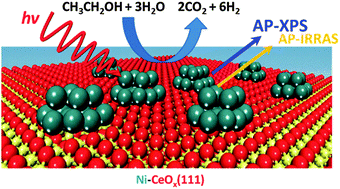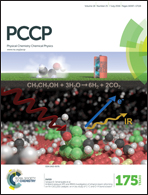Ambient pressure XPS and IRRAS investigation of ethanol steam reforming on Ni–CeO2(111) catalysts: an in situ study of C–C and O–H bond scission†
Abstract
Ambient-Pressure X-ray Photoelectron Spectroscopy (AP-XPS) and Infrared Reflection Absorption Spectroscopy (AP-IRRAS) have been used to elucidate the active sites and mechanistic steps associated with the ethanol steam reforming reaction (ESR) over Ni–CeO2(111) model catalysts. Our results reveal that surface layers of the ceria substrate are both highly reduced and hydroxylated under reaction conditions while the small supported Ni nanoparticles are present as Ni0/NixC. A multifunctional, synergistic role is highlighted in which Ni, CeOx and the interface provide an ensemble effect in the active chemistry that leads to H2. Ni0 is the active phase leading to both C–C and C–H bond cleavage in ethanol and it is also responsible for carbon accumulation. On the other hand, CeOx is important for the deprotonation of ethanol/water to ethoxy and OH intermediates. The active state of CeOx is a Ce3+(OH)x compound that results from extensive reduction by ethanol and the efficient dissociation of water. Additionally, we gain an important insight into the stability and selectivity of the catalyst by its effective water dissociation, where the accumulation of surface carbon can be mitigated by the increased presence of surface OH groups. The co-existence and cooperative interplay of Ni0 and Ce3+(OH)x through a metal–support interaction facilitate oxygen transfer, activation of ethanol/water as well as the removal of coke.


 Please wait while we load your content...
Please wait while we load your content...